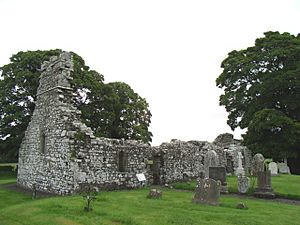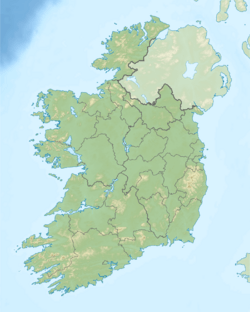Cannistown Church facts for kids
Quick facts for kids Cannistown Church |
|
|---|---|
| Ardsallagh Church Kennastown Church |
|
|
Teampall Bhaile Cheana
|
|
 |
|
| 53°37′07″N 6°40′04″W / 53.618516°N 6.667914°W | |
| Location | Ardsallagh, Navan, County Meath |
| Country | Ireland |
| Denomination | Pre-Reformation Catholic |
| History | |
| Dedication | Brigit of Kildare |
| Architecture | |
| Functional status | Ruins |
| Heritage designation | |
| Official name | Cannistown Church |
| Reference no. | 239 |
| Style | Anglo-Norman, Gothic |
| Years built | 12th–15th century |
| Groundbreaking | 12 century |
| Completed | 15th century |
| Closed | 16th century |
| Specifications | |
| Length | 22.85 m (75.0 ft) |
| Width | 7.25 m (23.8 ft) |
| Nave width | 5.45 m (17.9 ft) |
| Height | 7 m (23 ft) |
| Number of floors | 1 |
| Floor area | 57 m2 (610 sq ft) |
| Materials | sandstone, mortar, Old Red Sandstone |
| Administration | |
| Diocese | Meath |
Cannistown Church is a very old church in County Meath, Ireland. It is now a National Monument, which means it's a special historical site protected by the government. Even though it's in ruins, it tells us a lot about life long ago.
Contents
Where is Cannistown Church?
Cannistown Church is located on the west side of the River Boyne. It is about 4 kilometers (2.5 miles) south of Navan, a town in County Meath. The famous Hill of Tara is also nearby, about 5.8 kilometers (3.6 miles) to the southeast.
History of Cannistown Church
Early Beginnings
The area where Cannistown Church stands, called Ardsallagh, might have been home to an early Christian monastery. This monastery was possibly started by a saint named Finnian of Clonard in the 500s. It was known by different names, like Escair-Branain or Airdleac. Some old stories say that Saint Senach studied there with Finnian.
Building the Church
Cannistown Church was likely built in the 1100s. It was dedicated to Brigit of Kildare, a very important Irish saint. The Anglo-Normans, a group of people who came to Ireland from England and France, probably built it. The de Angulo / Nangle family, who were given the land, were likely responsible.
From the 1200s onwards, Cannistown Church was the main church for the local area. It was rebuilt and changed a bit in the 1400s or early 1500s. However, some parts of the original 1100s church are still there today. The chancel, which is the part of the church where the altar is, is a good example of this.
The Church in Records
A church in "Ardsalach" was mentioned in official tax records from the early 1300s. These records were for taxes collected by Pope Nicholas IV. This shows that the church was active and important at that time.
When the Church Closed
The church stopped being used around the 1500s, during a time called the Reformation. This was a period when big changes happened in the church. In 1612, a bishop named George Montgomery said that the church was "in ruins." This means it was already falling apart back then.
What the Church Looks Like Now
Cannistown Church today is mostly ruins, but you can still see its main parts. It has a nave (the main part where people sat) and a chancel (the area near the altar). Both parts have tall, pointed walls called gables. There are also remains of a small bell tower, called a bell-gable, at the west end.
Interesting Carvings
One of the most interesting parts of the church is the arch that leads into the chancel. It has special carved stones on each side. One carving shows three dogs attacking an otter or a fox. Another carving shows three men, which some people think might show the Arrest of Jesus from the Bible.
Other Features
Inside the church, you can find a single lancet window. This is a tall, narrow window with a pointed top. There is also an ambry on the north wall. An ambry is a small cupboard or recess in the wall where sacred items were kept. At the east end of the south wall, there is another lancet window and a piscina. A piscina is a stone basin used for washing sacred vessels. You can also see a small bullaun stone in the nave. Bullaun stones are ancient stones with bowl-shaped hollows, often linked to early Christian sites.


